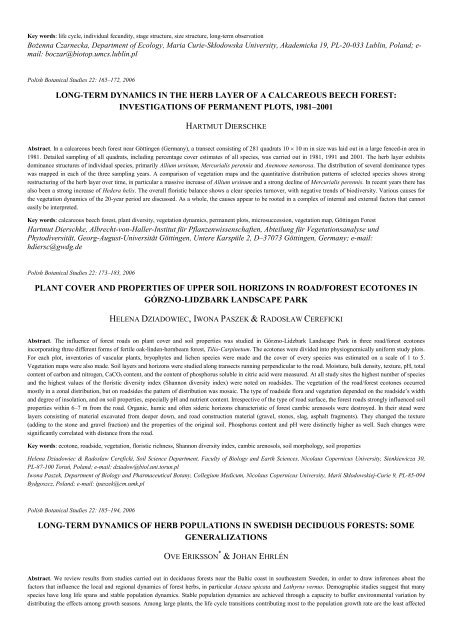Polish Botanical Studies 22 (2006)
Polish Botanical Studies 22 (2006)
Polish Botanical Studies 22 (2006)
Create successful ePaper yourself
Turn your PDF publications into a flip-book with our unique Google optimized e-Paper software.
Key words: life cycle, individual fecundity, stage structure, size structure, long-term observation<br />
BoŜenna Czarnecka, Department of Ecology, Maria Curie-Skłodowska University, Akademicka 19, PL-20-033 Lublin, Poland; e-<br />
mail: boczar@biotop.umcs.lublin.pl<br />
<strong>Polish</strong> <strong>Botanical</strong> <strong>Studies</strong> <strong>22</strong>: 165–172, <strong>2006</strong><br />
LONG-TERM DYNAMICS IN THE HERB LAYER OF A CALCAREOUS BEECH FOREST:<br />
INVESTIGATIONS OF PERMANENT PLOTS, 1981–2001<br />
HARTMUT DIERSCHKE<br />
Abstract. In a calcareous beech forest near Göttingen (Germany), a transect consisting of 281 quadrats 10 × 10 m in size was laid out in a large fenced-in area in<br />
1981. Detailed sampling of all quadrats, including percentage cover estimates of all species, was carried out in 1981, 1991 and 2001. The herb layer exhibits<br />
dominance structures of individual species, primarily Allium ursinum, Mercurialis perennis and Anemone nemorosa. The distribution of several dominance types<br />
was mapped in each of the three sampling years. A comparison of vegetation maps and the quantitative distribution patterns of selected species shows strong<br />
restructuring of the herb layer over time, in particular a massive increase of Allium ursinum and a strong decline of Mercurialis perennis. In recent years there has<br />
also been a strong increase of Hedera helix. The overall floristic balance shows a clear species turnover, with negative trends of biodiversity. Various causes for<br />
the vegetation dynamics of the 20-year period are discussed. As a whole, the causes appear to be rooted in a complex of internal and external factors that cannot<br />
easily be interpreted.<br />
Key words: calcareous beech forest, plant diversity, vegetation dynamics, permanent plots, microsuccession, vegetation map, Göttingen Forest<br />
Hartmut Dierschke, Albrecht-von-Haller-Institut für Pflanzenwissenschaften, Abteilung für Vegetationsanalyse und<br />
Phytodiversität, Georg-August-Universität Göttingen, Untere Karspüle 2, D–37073 Göttingen, Germany; e-mail:<br />
hdiersc@gwdg.de<br />
<strong>Polish</strong> <strong>Botanical</strong> <strong>Studies</strong> <strong>22</strong>: 173–183, <strong>2006</strong><br />
PLANT COVER AND PROPERTIES OF UPPER SOIL HORIZONS IN ROAD/FOREST ECOTONES IN<br />
GÓRZNO-LIDZBARK LANDSCAPE PARK<br />
HELENA DZIADOWIEC, IWONA PASZEK & RADOSŁAW CEREFICKI<br />
Abstract. The influence of forest roads on plant cover and soil properties was studied in Górzno-Lidzbark Landscape Park in three road/forest ecotones<br />
incorporating three different forms of fertile oak-linden-hornbeam forest, Tilio-Carpinetum. The ecotones were divided into physiognomically uniform study plots.<br />
For each plot, inventories of vascular plants, bryophytes and lichen species were made and the cover of every species was estimated on a scale of 1 to 5.<br />
Vegetation maps were also made. Soil layers and horizons were studied along transects running perpendicular to the road. Moisture, bulk density, texture, pH, total<br />
content of carbon and nitrogen, CaCO 3 content, and the content of phosphorus soluble in citric acid were measured. At all study sites the highest number of species<br />
and the highest values of the floristic diversity index (Shannon diversity index) were noted on roadsides. The vegetation of the road/forest ecotones occurred<br />
mostly in a zonal distribution, but on roadsides the pattern of distribution was mosaic. The type of roadside flora and vegetation depended on the roadside’s width<br />
and degree of insolation, and on soil properties, especially pH and nutrient content. Irrespective of the type of road surface, the forest roads strongly influenced soil<br />
properties within 6–7 m from the road. Organic, humic and often sideric horizons characteristic of forest cambic arenosols were destroyed. In their stead were<br />
layers consisting of material excavated from deeper down, and road construction material (gravel, stones, slag, asphalt fragments). They changed the texture<br />
(adding to the stone and gravel fraction) and the properties of the original soil. Phosphorus content and pH were distinctly higher as well. Such changes were<br />
significantly correlated with distance from the road.<br />
Key words: ecotone, roadside, vegetation, floristic richness, Shannon diversity index, cambic arenosols, soil morphology, soil properties<br />
Helena Dziadowiec & Radosław Cereficki, Soil Science Department, Faculty of Biology and Earth Sciences, Nicolaus Copernicus University, Sienkiewicza 30,<br />
PL-87-100 Toruń, Poland; e-mail: dziadow@biol.uni.torun.pl<br />
Iwona Paszek, Department of Biology and Pharmaceutical Botany, Collegium Medicum, Nicolaus Copernicus University, Marii Skłodowskiej-Curie 9, PL-85-094<br />
Bydgoszcz, Poland; e-mail: ipaszek@cm.umk.pl<br />
<strong>Polish</strong> <strong>Botanical</strong> <strong>Studies</strong> <strong>22</strong>: 185–194, <strong>2006</strong><br />
LONG-TERM DYNAMICS OF HERB POPULATIONS IN SWEDISH DECIDUOUS FORESTS: SOME<br />
GENERALIZATIONS<br />
OVE ERIKSSON * & JOHAN EHRLÉN<br />
Abstract. We review results from studies carried out in deciduous forests near the Baltic coast in southeastern Sweden, in order to draw inferences about the<br />
factors that influence the local and regional dynamics of forest herbs, in particular Actaea spicata and Lathyrus vernus. Demographic studies suggest that many<br />
species have long life spans and stable population dynamics. Stable population dynamics are achieved through a capacity to buffer environmental variation by<br />
distributing the effects among growth seasons. Among large plants, the life cycle transitions contributing most to the population growth rate are the least affected
















